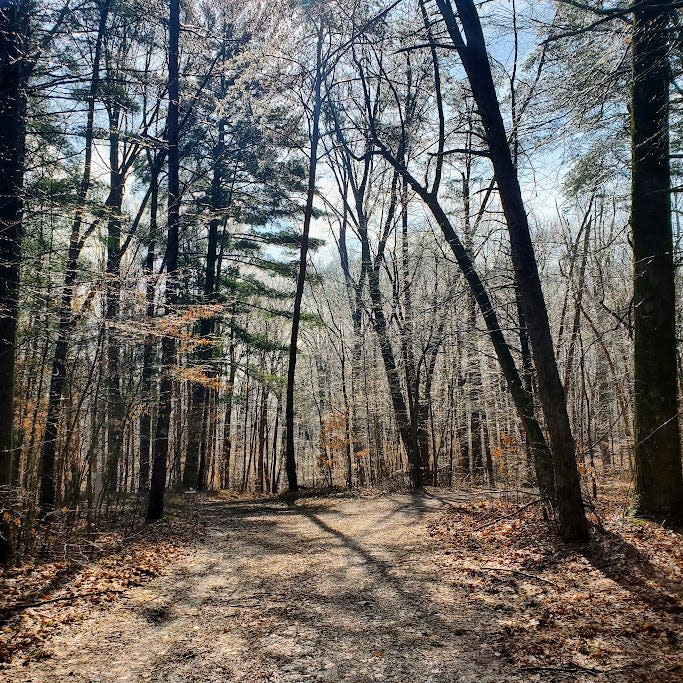Column: Owen-Putnam State Forest logging endangers plants, animals and our planet

My first visit to the Jordan Creek area of the Owen-Putnam State Forest was a wondrous morning. The tree needles were covered with a thin layer of ice that made the world sparkle as we headed up the trail. All was silent until the ice began to drop slowly as we made our way toward the “mother tree,” a long surviving tulip poplar.
We could only guess her age, but the bright red stripe around her circumference was alarming.
Not far downhill, a large gaping rock formation gave a fascinating shape to the landscape. Making our way through Christmas ferns, we discovered a large patch of shining club moss, whose genus Lycopodium was first published by Carl Linnaeus in 1753.
Learning that this forest, with so much rich history, was planned to be violated by large machines that would commercially log over 900 of the trees was shocking to me.
Since that first hike, I have visited the Owen-Putnam State Forest several more times in all four seasons. Spring and summer brought an extravagant display of native wildflowers. Later on, the fall season displayed a rainbow of diverse species that bestowed a different beauty, as migrating flocks pushed south. Each visit yields new and fascinating discoveries.
More in opinion:Teachers struggle to balance the needs of one and the needs of many
Learning about the cultural and natural history of the area strengthens my belief that the area should remain undisturbed for all those enjoying camping, hiking, hunting, foraging and horseback riding in this special place. The homesteads, graves, and campgrounds tie people to this land through stories, reunions, the 50/50 race, and most importantly, memories of sharing these.
I realize that there is a state park just down the road from the Owen-Putnam, but state forests offer an experience of nature as it once was, secluded, primitive camping and natural, quiet trails where one can see and hear very little other than the sounds and sights that emanate from the wilderness itself.
Designating the Jordan Creek area as a High Conservation Value Forest will help it endure with considerably less disturbance than the proposed management plans for individual tracts, enabling the older trees to remain as (increasingly effective) carbon sinks and continue to filter the air and water, as well as provide the beauty of a naturally maturing forest.
Documentation exists that includes northern long-eared bats, tri-colored bats, American badgers, endangered pygmy shrews, state endangered cerulean warbler, shining club moss, and ostrich ferns in this area. The vulnerable plant and animal species, unique geological features and hydrology should likewise remain undisturbed. The climate crisis dictates that every tree in the forest be considered precious in order to build resilience.
More in opinion:Lake Monroe is our water source. How can we protect it against climate change?
Plans for our state forest should be updated to include recent research that demonstrates that maturing forests are more effective in removing CO2 from the atmosphere, especially in the crucial near-term. Nature-based solutions are a critical measure to keep America’s Paris commitment within reach. To meet this commitment, natural land sinks would be responsible for about 8% of the needed greenhouse gas reductions, sequestering about a quarter more carbon per year in 2030 than they do today.
In these uncertain times, more than ever, people seek solace in these special places. The timber harvest as proposed would remove 9% of the trees in the Owen-Putnam, and an even higher percentage of the total tree volume, likely causing damage to the ecological quality and CO2 sequestration potential.
Please write to Gov. Eric Holcomb and your state legislators now to ask for their help to certify the Jordan Creek area as a High Conservation Value Forest. Write Gov. Holcomb an email at govholcomb@gov.in.gov. Find your state legislators contact information at https://iga.in.gov/legislative/find-legislators/
To volunteer to do more or join our contact list, email Marilyn Bauchat at marilynbauchat@gmail.com
Marilyn Bauchat is a resident of Bloomington, the Sierra Club Uplands network chair, SC Hoosier Chapter vice chair and a volunteer for Citizens' Climate Lobby South Central Group.
This article originally appeared on The Herald-Times: Columnist writes logging in state forest undermines carbon sinks

